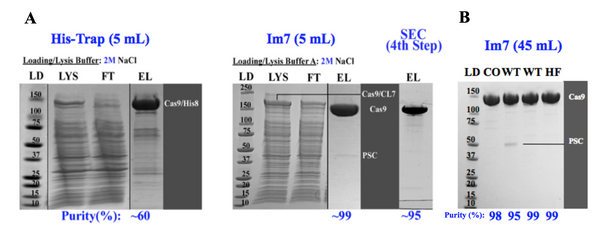Purifying Cas Proteins and Complexes: Part II

This blog post is the second in a series that spotlights proteins that have been purified by the CL7/Im7 system. This is the second of two installments detailing Cas9 purification.
Cas9 requires high purity in order to achieve high activity as a part of the CRISPR system for genetic modification. Researchers from Hubei University in Wuhan, China used TriAltus’ CL7/Im7 system successfully to purify Cas protein and Cas RNP complexes. Due to a growing demand for pure Cas proteins and an effort to improve their production, TriAltus conducted its own purification runs of Cas9 with success.
Use ultra-pure Cas9 in your research
TriAltus’ Cas9 purification
After the Hubei group’s successful purification of Cas9 RNPs, TriAltus ran its own tests of Cas9 purification. In order to prove the efficacy of CL7 in purifying a key protein, two identical runs were conducted: one using His8 and SUMO tags and one using CL7 and MBP tags. The two workflows are illustrated in Figure 1.

Loading/lysis buffer was consistent between the two runs at 2M NaCl, and both used 5 ml of chromatography beads. Cas9/His8 resulted in only about 60% purity, with the contaminants being leftover proteins from E. coli. In contrast, Cas9/CL7 achieved near-perfect purity of 99%. Cas9/His8 only achieved 95% purity after the 4th step (Figure 2A). When the Im7 column run was scaled up to 100g of cells and the optional second step was used to remove trace amounts of PSC protease, the product was 99% pure (Figure 2B).

Proven Cas9 activity
Cas9 obtained from a commercial source (CO) or CL7/Im7-purified Cas9 (Im7) was complexed with equimolar (+), or without (-), an annealed sgRNA (Figure 3). Complexes were incubated at different concentrations with a 1.1 kb target DNA fragment for 15 minutes at 37°C. The sgRNA recognizes a sequence in the middle of the target DNA, resulting in ~550 bp fragments upon cleavage. CL7-purified Cas9 showed comparable activity to commercial Cas9.

CL7-purified Cas9 also showed the same activity in cells as the His8/four-step-purified Cas9. Human sickle cell iPSCs (induced pluripotent stem cells) were electroporated with Lonza nucleofector 2b and varying concentrations of RNP using Cas9WT from either the 4-step purification (His8) or 1-step purification protocols (CL7). RNPs made with Cas9 purified using the two protocols were tested using a sgRNA designed to correct a 1-bp error in hemoglobin that causes sickle cell disease. Modification rates were evaluated by digital PCR. The proteins resulted in the same viability and modification rates, indicating equivalent efficiency in cells. These tests were performed by Tim Townes and Lei Ding of the University of Alabama Birmingham (UAB).
Conclusion
Cas9 will continue to be an essential component in the refinement and development of CRISPR technology. As more scientists turn their attention to CRISPR and Cas9, it will be important that they use the highest quality Cas9 products to generate optimal results. The CL7/Im7 tag system has emerged as a strong candidate for producing high-quality Cas9 and will continue to play a role in its future use.
Read Part I of this blog post about Hubei University researchers’ purification of Cas9 RNPs.
